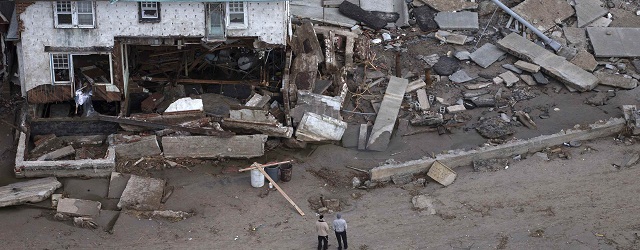
Forecasts point to an increase in median temperatures of up to 5ºC more before the end of this century. The increase in climate change brought about by global warming does not, strictly speaking, lend itself to forecasts; the bad thing is that, up until now, all the forecasts have been rendered inaccurate by the sheer speed and intensity of events and their impact—in short, by reality.
James Hansen’s paper on Perception of Climate Change, published last summer by PNAS (Proceedings of the National Academy of Sciences) and mentioned in The Economist, states that the “climate dice” (a term used to describe the chance of unusually warm or cool seasons) has shifted towards unusually warm spells over the past thirty years. Thanks to global warming, another new category has emerged: “extremely high summertime temperatures”. This “extreme heat”, which during the base period (1951-1980) covered much less than 1% of the Earth’s surface, now covers about 10% of the land area. The seasonal temperature deviations have shifted unmistakably towards high temperatures and the range of anomalies has increased.
What does “global warming” really mean? As well as temperature increases, it means alterations in the frequency and intensity of extreme weather phenomena, with 2011 beating all existing records in the USA: annual losses caused by these phenomena have gone from a few billion US dollars in 1980 to more than 200 billion dollars today, according to the IPCC Special Report on Managing the Risks of Extreme Events. Other phenomena related to global warming such as the rise in sea levels, changes in the frequency and intensity of heavy precipitation and wind events, the increase of cyclones, the fall in farm productivity, the increasing scarcity of potable water or the loss of biodiversity, are just a few of the global phenomena that will cause significant regional impacts.
Let’s focus further on a particularly sensitive issue: water. One of the immediate impacts expected is the growing scarcity of drinking water: in the Mediterranean region and Africa and Southern Africa, increased drought levels and the subsequent drop in surface run off (by more than 30%), and in large areas of China, India (the Himalayas alone are home to more than 50,000 glaciers that feed into 10 major rivers that are vital to the water supply in Asia—the Amu Darya, the Indus, the Ganges, the Brahmaputra, the Irrawaddy, the Salween, the Mekong, the Yangtze, the Hu nag He and the Tarim—on which 1.3 billion people depend for their water supply, and the Andes, as a result of glacier ice melting in the mountains which provide seasonal water for a number of rivers.
“Water is going to run out longer before oil does” warned Nestlé Chairman Peter Brabeck-Letmathe, in the last OECD forum held last May.
Regarding water-related phenomena, drought and flooding and their effects on food are major issues. Two forecasts based on cutting-edge predictive models paint a somber picture unless changes are made urgently:
Researcher Aiguo Dai uses a predictive model that analyzes changes in the worldwide aridity over the period 1923-2010 and concludes that these changes point towards severe and prolonged periods of drought for the next 30-90 years as a result of lower rainfall precipitations and increasing evaporation.
Between 100 and 200 million people a year fell prey to flooding, drought and other water-related disasters; nearly two-thirds of these disasters are caused by flooding. The OECD’s Environmental Outlook 2050 calculates that the number or people at risk of suffering the consequences of flooding will rise from today’s figure of 1.2 billion to approximately 1.6 billion in 2050—that’s nearly 20% of the planet’s population! The economic value of the assets at risk will come to 45 trillion dollars in 2050, a figure 340% higher than in 2010.
Speaking on food prices crisis and volatility, in a Financial Times article, the Head of Investments at GMO, Jeremy Grantham, warned that the impact of current climate change effects on drought and flooding are being seriously underestimated.
We are already faced with one of the consequences: the food price volatility. The US corn crisis, brought on by the worst drought seen in the USA since the 1950’s, is directly related to global warming. Moreover, as Stanford’s Noah Diffenbaugh states in a study published in Nature Climate Change, it shows that US corn price volatility is far more sensitive to the immediate effects of climate change than to energy policies (such as production quotas for bio-fuels).
The evidence on the dramatic effects of global warming are more and numerous and serious by the day, and their consequences represent a futile waste of human life, and lead to the deterioration of vast eco-systems which, in turn speeds up global warming. We are witnessing the destruction of a part of our historic and cultural essence, greater volatility of basic food prices (wheat, corn, rice) and the ever-diminishing security of their supply due to protectionist measures in the countries where they are produced (Russia in 2010, India in 2011).
Science has made it clear that the causes of global warming are, by and large, human-made, the term: Anthropocene, is already in use to name the era we are now entering. Global overpopulation and the Western world excessive consumption lifestyle are to blame, as its increasing demand for energy is satisfied by producing fossil fuels whose large-scale combustion is highly polluting, as is the case of coal, oil and, to a lesser extent, gas; main CO2 producers and responsible for heating the planet.





